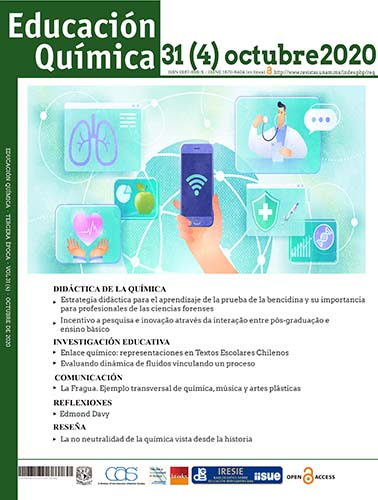El vanadio, desde su descubrimiento hasta su papel en la vida
Contenido principal del artículo
Resumen
El vanadio es un elemento químico con una historia peculiar y tan fascinante como su química. Fue descubierto en el municipio argentífero de Zimapán, México, por Andrés Manuel Del Río, y redescubierto en Suecia por Nils Gabriel Sefström, quien lo nombró vanadio, en honor de la diosa nórdica Vanadis. El vanadio es el elemento número 22 más abundante en la corteza terrestre, y después del molibdeno, el segundo metal de transición con mayor presencia en disolución en el ambiente marino. Forma parte de más de 200 minerales entre los que se encuentra la vanadinita, Pb5(VO4)3Cl, y recientemente se encontró en su forma nativa en sublimados de fumarolas del cráter del volcán de Colima en México. El papel del vanadio en sistemas biológicos ha despertado el interés de la comunidad científica debido a varios hechos extraordinarios. Existen organismos exóticos que lo acumulan en cantidades excepcionales como las ascidias y los hongos alucinógenos del género Amanita. Además, se encuentra en la nitrogenasa de Azobacter vinelandii formando parte del cofactor FeVco, componente organometálico responsable de la “fijación” del nitrógeno atmosférico; también se presenta en las enzimas vanadio haloperoxidasas, las cuales intervienen indirectamente en el agotamiento del ozono atmosférico. A pesar de que la actividad antidiabetica del vanadio ha quedado bien establecida para sus estados de oxidación +4 y +5, actualmente no existe un medicamente basado en este metal para el tratamiento de la diabetes mellitus, enfermedad que actualmente padecen casi 13 millones de mexicanos.
Detalles del artículo
Citas en Dimensions Service

Educación Química por Universidad Nacional Autónoma de México se distribuye bajo una Licencia Creative Commons Atribución-NoComercial-SinDerivar 4.0 Internacional.
Basada en una obra en http://www.revistas.unam.mx/index.php/req.




